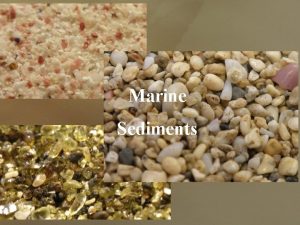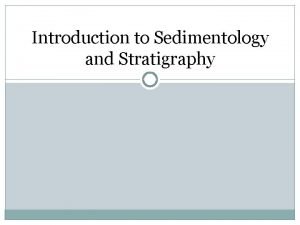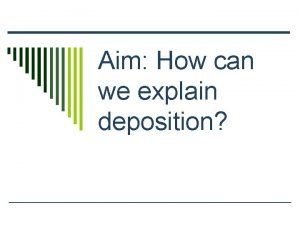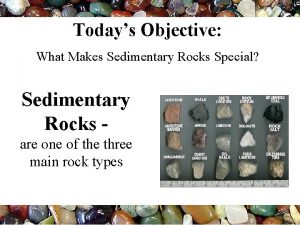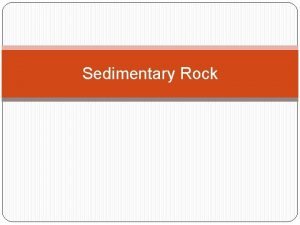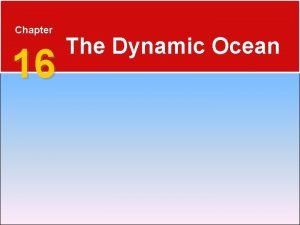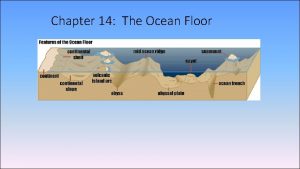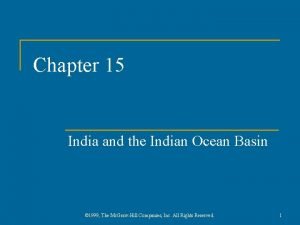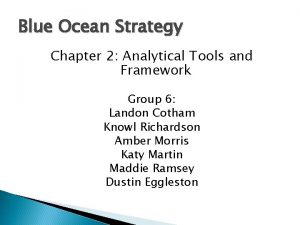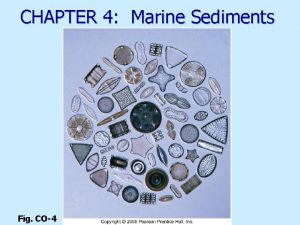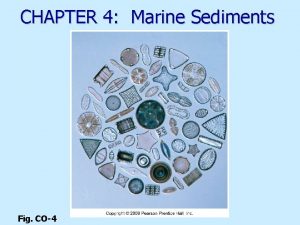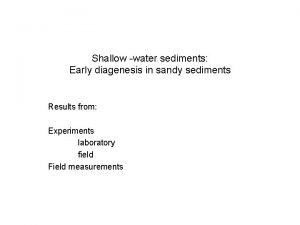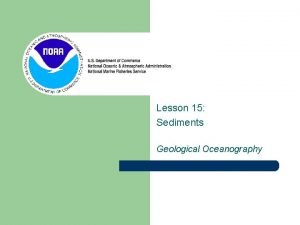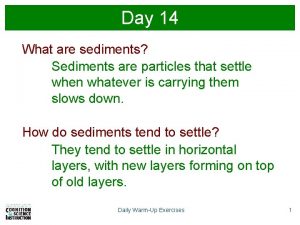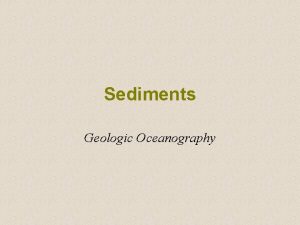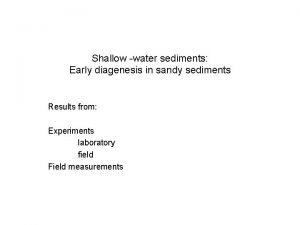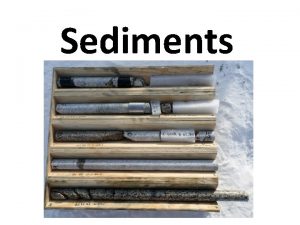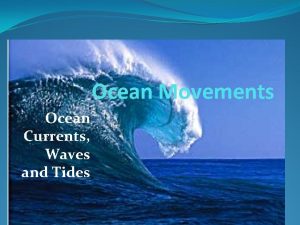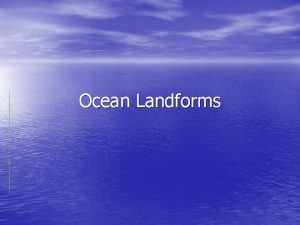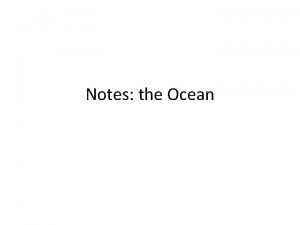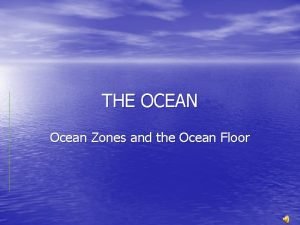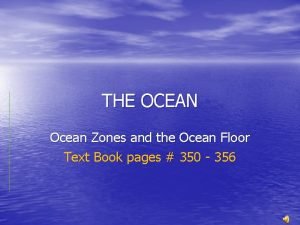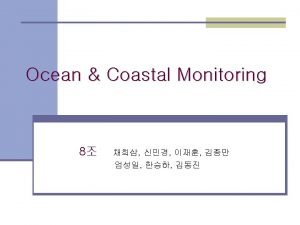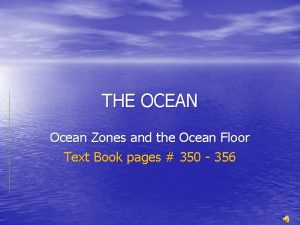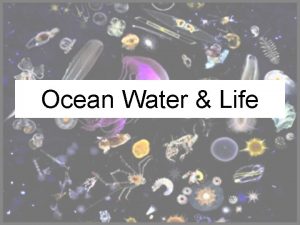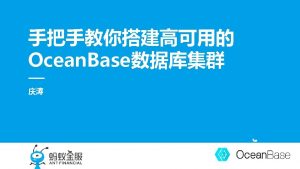Chapter 5 Ocean Sediments Chapter 5 Topics Sediments




















- Slides: 20

Chapter 5: Ocean Sediments

Chapter 5 Topics Sediments Vary Greatly in Appearance Sediments May Be Classified by Particle Size Sediments May Be Classified by Source Neritic Sediments Overlie Continental Margins Pelagic Sediments Vary in Composition and Thickness Scientists Use Sensitive Tools to Study Ocean Sediments Are Historical Records of Ocean Processes Marine Sediments Are Economically Important

Chapter 5 Five Basic Ideas Sediments are loose accumulations of particulate material. Their depth and composition tell us of relatively recent events in the ocean above. The most abundant sediments are terrigenous (from land) and biogenous (from once-living things). The volume of terrigenous sediment exceeds that of biogenous sediment, but biogenous material covers a greater area. Marine sediments have been uplifted and exposed on land. Because marine sediments are usually subducted along with the seabed on which they lie, the oldest sediments are relatively young. Analysis of marine sediments can suggest past climates, and perhaps predict upcoming climate change.

Ocean Sediments Vary Greatly in Appearance Sediments are particles of organic or inorganic matter that accumulate in loose, unconsolidated forms. Marine sediments can vary by a number of different characteristics: Size Source Location Color

Ocean Sediments can be Classified by Particle Size Sediments can be classified by particle size. Waves and currents generally transport smaller particles farther than larger particles.

Sediment Transport and Deposition are Related to Particle Size and Current Velocity The velocities of currents required for erosion, transportation, and deposition (sedimentation) of sediment particles of different sizes. To dislodge and carry a particle of size A, the speed of a current must exceed 20 centimeters per second (8 inches per second). When the current falls below 1 centimeter per second (1/2 inch per second), the particle will be deposited.

Sediments May Be Classified By Source

Terrigenous Sediments Come from Land The Sediment Cycle Over geological time, mountains rise as lithospheric (crustal) plates collide, fuse, and subduct. Water and wind erode the mountains and transport resulting sediment to the sea. The sediments are deposited on the seafloor, where they travel with the plate and are either uplifted or subducted. Thus, the material is eventually made into mountains again.

Marine Sediments Are Usually Both Terrigenous and Biogenous Deposits The sediment of continental shelves is called neritic sediment, and contains mostly terrigenous material. Sediments of the slope, rise, and deep-ocean floors are pelagic sediments, and contain a greater proportion of biogenous material.

Marine Sediments Are Usually Both Terrigenous and Biogenous Deposits The general pattern of sediments on the ocean floor. Note the dominance of diatom oozes at high latitudes. What differences in the type and distribution of sediments do you note between the Atlantic Ocean and the Pacific Ocean?

Pelagic Sediments Vary in Composition and Thickness • Turbidites – deposits made by turbidity currents • Oozes – sediment containing at least 30% biogenous material – Siliceous oozes are formed by organisms that contain silica in their shells. Diatoms are one type of organism whose remains contribute to siliceous ooze. – Calcareous oozes are formed by organisms, such as foraminifera, which contain calcium carbonate in their shells. • Hydrogenous sediments - originate from chemical reactions that occur in the existing sediment. – Are often found in the form of nodules containing manganese and iron oxides – Evaporites are salts that precipitate as evaporation occurs and include many salts with economic importance.

Turbidites Are Deposited on the Seabed by Turbidity Currents The formation of turbidites The turbidity current moves quickly down the continental shelf and slope, sometimes encountering (and further eroding) a submarine canyon. When the material comes to rest, it sorts into layers with coarse sediment at the bottom and finer sediment above. Each graded layer is the result of one turbidity current event.

Oozes Form from the Rigid Remains of Living Creatures Although calcareous organisms live in nearly all surface ocean water, calcareous ooze does not accumulate everywhere on the ocean floor. Shells are dissolved by sea water at great depths because the seawater there becomes slightly acidic. This depth is known as the calcium carbonate compensation depth (CCD) is where the rate at which calcareous sediments accumulate equals the rate at which those sediments dissolve.

Hydrogenous Materials Precipitate Out of Seawater Itself Examples of hydrogenous sediments: (LEFT) A manganese nodule; (MIDDLE) rock probably formed by the lithification of evaporites left behind as a shallow inland sea dried up; (RIGHT) A small change in the p. H or temperature of seawater can cause calcium carbonate to precipitate from water as oolites.

Scientists Use Sensitive Tools to Study Ocean Sediments How do scientists study sediments? • • • Deep-water cameras Clamshell samplers Piston Corers Core libraries Seismic profilers

Scientists Use Sensitive Tools to Study Ocean Sediments One method of studying sediments uses a clamshell sampler (Peterson Grab). The sampler can be used to obtain a relatively undisturbed sediment sample.

Scientists Use Sensitive Tools to Study Ocean Sediments One method of obtaining core samples by research vessels such as the JOIDES Resolution is by using a piston corer. The corer allows a cylinder of sediment to be taken for analysis to determine the age of the material, as well as the density, strength, molecular composition and radioactivity of the sediment.

Sediments Are Historical Records of Ocean Processes What can scientists learn by studying sediments? • • Historical information Location of natural resources, especially crude oil and natural gas • Marine sediments are important as historical records and a site of natural resources. • Analysis of seabed sediment cores was key to understanding the extinction of the dinosaurs and the Paleocene-Eocene thermal maximum (PETM).

Marine Sediments Are Economically Important In 2010, an estimated 39% of the world’s crude oil and 35% of its natural gas was extracted from the sedimentary deposits of continental shelves and continental rises. Offshore hydrocarbons currently generate annual revenues in excess of $200 billion. In 2005, sand gravel valued at more than $550 million were taken from the ocean. Commercial mining of manganese nodules has also been considered.

January 2015. The R/V Sonne, a German research ship, was several hundred miles east of Barbados when a mesh net meant to capture marine life instead brought up balls of manganese ore that were bigger than softballs. A remote camera later revealed that the seafloor was littered with these round manganese nodules, some the size of bowling balls.
 Nekton include all animals that
Nekton include all animals that Divergent convergent transform
Divergent convergent transform Ocean ocean convergent boundary
Ocean ocean convergent boundary Convergent boundary
Convergent boundary Ocean ocean convergent boundary
Ocean ocean convergent boundary Convergent plate boundary
Convergent plate boundary Ocean to ocean convergent boundary
Ocean to ocean convergent boundary Blue og red ocean
Blue og red ocean Classification of marine sediments
Classification of marine sediments Sedimentology
Sedimentology A low hill is composed of unsorted sediments
A low hill is composed of unsorted sediments A process that squeezes or compacts sediments
A process that squeezes or compacts sediments A process that squeezes, or compacts, sediments
A process that squeezes, or compacts, sediments Biochemical sedimentary rocks
Biochemical sedimentary rocks The process that presses sediments together
The process that presses sediments together Biogenous sediment definition
Biogenous sediment definition Chapter 9 topics in analytic geometry
Chapter 9 topics in analytic geometry Chapter 16 the dynamic ocean
Chapter 16 the dynamic ocean Chapter 14 the ocean floor answer key
Chapter 14 the ocean floor answer key Chapter 15 india and the indian ocean basin notes
Chapter 15 india and the indian ocean basin notes Southwest airlines
Southwest airlines








